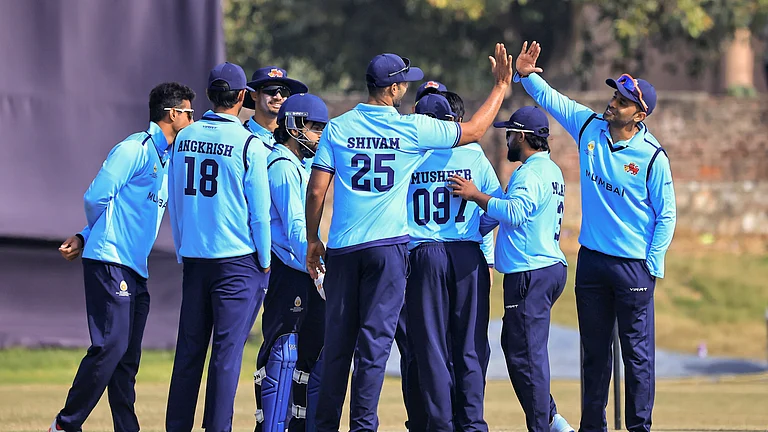As I sat for a hearty brunch at Roseate, New Delhi, Executive Chef Anand Panwar gave me an exotic looking and even better-tasting detox salad using lavender and Japanese honeysuckle. I instantly fell in love with the summer salad because it was not just beautiful to look at, but tasted fabulously floral.
Talking about the medicinal properties Panwar said, “Japanese honey suckle is used in Oriental medicine as it helps in bringing down the blood sugar level. It is also a natural detoxifier and cleanses the liver and kidney. Lavender again is one of the best flowers to boost your immunity.”

Lavender Salad by Chef Anand Panwar
Cooking with flowers is fun because there are a variety of flavours that a garden can offer. “Begonia, carnation, lilies, daisy, hibiscus, lilac, marigold, pansy, peony, rose, sunflower, tulip, violet, I think given the choice, I would love to use the offerings of an entire garden. Right from sweet and bitter to light, peppery and citrus, there are a range of tastes that a flower can add to the dish. Cooking with flower is a trend than fad," Panwar said.
Adding flowers compliments fruit-based and chocolate desserts. Deeksha Shetty, Chef-Proprietor of CocoaMayaPatisserie says, “The demand for flower induced food has increased drastically. People want to try new things and want to keep up to the trend. Demand for gulkand which is made of rose petals has increased. Earlier there was less awareness about edible flowers that can be used for cooking and baking. In the past few years, bakers have tried experimenting and there has been a hike in usage as demand has been more.”
“Whenever I use to go to Mangalore to visit my cousins, my aunt would make chocolate fudge and add pink borage paste, which gave a very unique flavour to it. Back then, I was unaware why chocolate fudge baked by her tasted better than others. However, during my culinary training I checked with my aunt and that is when I discovered her secret. Also, garnishing on top makes it look pretty and for millennials it is Instagram worthy,” Shetty fondly remembers.
Roses are incorporated in various cuisines especially the Middle Eastern Cuisine, for their decadent flavour and aroma. Chef Reetu Uday Kugaji says, “These edible flowers not only enhance the appearance but impart flavour and increase nutritive value of the dish. Rose petals aid in weight loss, relieve stress and depression and act as a natural aphrodisiac.”
Nutritionist Avini Kaul says, “While they can enhance the appearance and flavour of finished food and drinks, the opportunities for flowers certainly do not end there. There are a lot of health benefits packed in the buds. Flowers are natural plant foods, and like many plant foods in nature often contain valuable nutrients for your health. For instance, dandelions contain numerous antioxidant properties and flavonoids, including four times the beta carotene of broccoli, as well as lutein, cryptoxanthinand zeaxanthin. They are also a rich source of vitamins, including folic acid, riboflavin, niacin, Vitamins E and Vitamin C.”
Banana blossoms are extremely popular in South Indian cuisine. They are rich in fibre, minerals like potassium, calcium, phosphorus, iron, copper and magnesium The Vazhaapoo Thatta Adai (banana blossom cutlet), a South Indian delicacy made by Chef Velu Murugan from Dakshin at Sheraton New Delhi was an absolute delight. Talking about this dish Murugan said, “This special cutlet made with banana blossom and potatoes, which I had learnt from my grandmother brings back fond memories of my childhood days.”

Banana blossom cutlet by Chef Velu Murugan
In Bengali cuisine, nothing is wasted. We eat the leaves, stems, barks, seeds, peels and even flowers of a plant. Chef Ananya Banerjee says, “Like Italian zucchini flower fritters, Bengalis use a lot of flowers to make bhaja (fritters). Have grown up eating kumro phool bhaja, (pumpkin flower fritter), bauk phool bhaja. Sojne Phool (drumstick flower fritter) and mocha (banana flower) to name a few. Although, many of these flowers are seasonal and you have to wait for the right time of the year to obtain them. Bok phool are as pretty and fresh to be used as house decor. They can also be turned into a plate of fritters by dipping it in gram flour or rice flour and taste perfect with a cup of tea.
One of the famed delicacies of Bengali cuisine is Mochar Ghonto- done with banana blossom teamed with prawns and coconut. Banana blossom is extremely popular in South Indian cuisine too. It is rich in fibre, minerals like potassium, calcium, phosphorus, iron, copper and magnesium. If you ask any Bengali, they will surely mention about Mochar chop which is a cutlet made from banana blossom. It is a vegan Bengali street food and the taste is very close to a minced mutton cutlet.

Mochar Ghonto (banana blossom curry) by Chef Ananya Banerjee
Food blogger from Mumbai, Alka Keswani, says, “In Sindhi community a lactating mother consumes ample quantities of drumstick pods curry, or a curry made from fresh or sundried drumstick flowers (known as Suhanjhro/swanjhro in Sindhi) cooked with onions and garlic, since drumstick pods and flowers contain many vital amino acids. Drumstick flowers are also rich sources of calcium and potassium and possess excellent antibacterial and antioxidant properties.”
Drumsticks or moringa flowers boiled with milk, cardamom and sugar act as an energy booster. A decoction made by boiling flowers with tea is used to treat UTI. Moringa flowers are also believed to be useful in treating ulcers, mouth sores and inflammation. Suhanjhro and Swanjhro subzi which is cooked using drumstick flower and lotus stem is very popular in Sindhi cuisine and is often relished with some khichdi in summers and with patted jowar roti, known as Dodoh in winters. “Boiled buds and flowers are drained, squeezed and used to make subzi or added to beaten curds to make a raita rich in flavours due to addition of chopped green chilies, ginger and coriander leaves. At times, lotus stem is added to Suhanjhro, to lift the flavours of the earthy moringa flowers, a notch higher,” adds Keswani.
POINTS TO REMEBER WHEN COOKING WITH FLOWERS:
- Not all flowers can be used for cooking. Lots of flowers are poisonous and can cause allergy in your body
- The secret to success behind the use of flowers in your cooking is to keep your dish simple
- Don’t add too many spices while using flowers because flowers on their own have a very delicate and individualistic flavour






.JPG?w=801&auto=format%2Ccompress&fit=max&format=webp&dpr=1.0)



















